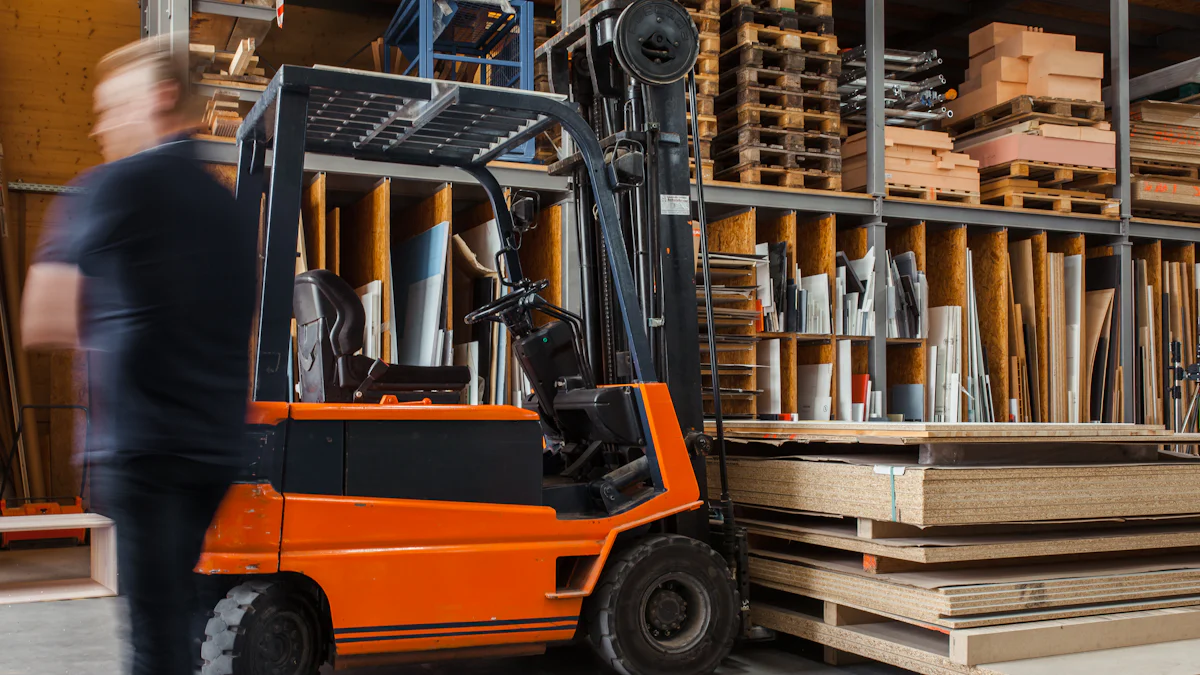
Material handling plays a crucial role in various industries. Efficient material handling improves operational productivity and employee morale. Pallet jacks are essential tools for moving palletized loads within warehouses and other facilities. This blog will explore different types of pallet jacks, their benefits, and applications in material handling.
Types of Pallet Jacks

Manual Pallet Jacks
Features
Manual pallet jacks offer a cost-effective solution for material handling. These tools do not require electricity, making them always ready for use. The design includes a hydraulic pump that allows operators to lift and lower loads with ease. The handle provides steering control, enabling precise maneuverability in tight spaces. Manual models typically feature durable construction, ensuring longevity even under frequent use.
Uses
Warehouses often utilize manual pallet jacks to move pallets over short distances. These tools excel in environments where space is limited and electric options may be impractical. Retail stores also benefit from using manual models for stocking shelves and organizing inventory. Construction sites find these jacks useful for transporting materials across uneven terrain.
Electric Pallet Jacks
Features
Electric pallet jacks incorporate advanced technology to enhance efficiency and productivity. These models come equipped with rechargeable batteries, providing the power needed for extended operations. The electric motor assists in lifting and moving heavy loads, reducing physical strain on workers. Many electric versions include features such as speed controls and ergonomic handles for improved user comfort.
Uses
The versatility of electric pallet jacks makes them indispensable in various industries including warehousing, storage, and manufacturing. Distribution centers rely on these tools for quick loading and unloading of goods from trucks. Manufacturing facilities use electric models to transport raw materials to production lines efficiently. Warehouses benefit from the increased speed and reduced worker fatigue associated with electric options.
Specialized Pallet Jacks
Adjustable Pallet Jacks
Adjustable pallet jacks provide flexibility by allowing users to modify the fork width according to specific load requirements. This feature proves invaluable when handling different types of pallets or containers within the same facility.
Low Profile Pallet Jacks
Low profile pallet jacks are designed for situations where standard forks cannot fit under certain pallets or skids due to their height constraints. These specialized models have a lower minimum height, making them ideal for accessing low-clearance items.
Heavy Duty Pallet Jacks
For exceptionally heavy loads, heavy duty pallet jacks offer robust construction capable of supporting greater weight capacities than standard models can handle. These tools are essential in industries dealing with bulk materials or oversized equipment.
“The right type of pallet jack can significantly improve operational efficiency,” says industry expert John Doe.
Each type of pallet jack, whether manual, electric, or specialized, serves unique purposes tailored to specific operational needs within various industries.
Benefits of Using Pallet Jacks
Efficiency
Speed of Operations
Pallet jacks significantly enhance the speed of operations in material handling. Manual models allow workers to quickly move pallets over short distances without requiring complex machinery. This simplicity ensures that tasks are completed promptly, reducing downtime and increasing overall productivity.
Electric pallet jacks take efficiency a step further by incorporating advanced technology. These models come with rechargeable batteries and electric motors, which enable faster movement of heavier loads. The motorized assistance reduces the time needed to transport materials across large warehouses or distribution centers. As a result, businesses can handle higher volumes of goods in less time.
Reduced Worker Strain
The design of pallet jacks focuses on minimizing physical strain for operators. Manual versions include hydraulic pumps that make lifting and lowering loads easier, thereby reducing the effort required from workers. This ergonomic design helps prevent injuries related to manual lifting and carrying.
Electric pallet jacks offer even greater benefits in terms of worker strain reduction. The electric motor handles most of the heavy lifting, allowing operators to focus on steering and positioning the load. This feature is particularly valuable in environments where employees must move heavy items frequently throughout their shifts.
Cost-Effectiveness
Lower Initial Investment
One of the primary advantages of using pallet jacks is their cost-effectiveness. Manual models have a lower initial investment compared to other material handling equipment like forklifts. Businesses can equip their facilities with multiple manual pallet jacks without incurring significant expenses.
Electric pallet jacks, while more expensive than manual ones, still represent a cost-effective solution for many operations. The increased efficiency and reduced labor costs associated with electric models often justify the higher upfront price.
Maintenance Costs
Maintenance costs for pallet jacks are generally low compared to other types of material handling equipment. Manual versions require minimal upkeep due to their simple mechanical design. Regular checks and occasional lubrication are usually sufficient to keep them in good working condition.
Electric pallet jacks also benefit from relatively low maintenance requirements. While they do involve more complex components like batteries and motors, these parts are designed for durability and long-term use. Routine maintenance ensures that electric models remain operational without incurring high repair costs.
Versatility
Handling Various Loads
The versatility of pallet jacks makes them indispensable tools in various industries. Manual models can handle a wide range of pallet sizes and weights, making them suitable for diverse applications within warehouses, retail stores, and construction sites.
Electric pallet jacks excel at transporting heavier loads that would be challenging for manual versions to manage. Their robust construction allows them to carry substantial weights efficiently, making them ideal for high-volume tasks in manufacturing facilities or distribution centers.
Specialized types like adjustable pallet jacks offer additional flexibility by allowing users to modify fork widths according to specific load requirements. This adaptability proves invaluable when dealing with different types of pallets or containers within the same facility.
Maneuverability in Tight Spaces
The compact design of many pallet jack models enhances maneuverability in confined spaces. Manual versions are particularly effective in navigating narrow aisles or crowded storage areas where larger equipment may struggle to operate efficiently.
Electric pallet jacks, despite being more substantial than manual ones, still provide excellent maneuverability thanks to features like speed controls and ergonomic handles. These attributes enable precise control even in tight quarters, ensuring smooth operation without compromising safety or efficiency.
“Choosing the right type of pallet jack can transform your material handling processes,” says industry expert Jane Smith.
Applications of Pallet Jacks

Warehousing
Loading and Unloading
Pallet jacks play a pivotal role in warehousing operations, particularly in loading and unloading tasks. Manual models offer a straightforward solution for moving goods from delivery trucks to storage areas. Workers can easily maneuver these tools through narrow spaces, ensuring efficient handling of incoming shipments. Electric pallet jacks, with their motorized assistance, further streamline the process by reducing the physical effort required. This results in faster turnaround times and increased productivity.
Inventory Management
Effective inventory management relies heavily on the use of pallet jacks. These tools facilitate the quick movement of goods within the warehouse, allowing for seamless organization and retrieval. Manual versions are ideal for smaller warehouses where space constraints make larger equipment impractical. Electric models excel in larger facilities where speed and efficiency are paramount. The ability to handle various load sizes ensures that inventory remains well-organized and accessible at all times.
Manufacturing
Material Transport
In manufacturing environments, pallet jacks serve as essential tools for material transport. Workers use manual models to move raw materials from storage areas to production lines efficiently. The simplicity of these tools allows for quick deployment without the need for extensive training or maintenance. Electric pallet jacks enhance this process by providing additional power for heavier loads, ensuring that materials reach their destination promptly.
Assembly Line Support
Assembly lines benefit significantly from the integration of pallet jacks into their workflows. Manual versions offer flexibility in transporting components between different stages of production. Workers can easily navigate through tight spaces and crowded areas, maintaining a steady flow of materials along the assembly line. Electric models provide added efficiency by reducing worker fatigue and increasing the speed at which components are delivered.
Distribution Centers
Order Fulfillment
Order fulfillment processes in distribution centers rely on the efficiency provided by pallet jacks. Manual versions enable workers to pick and transport items quickly within confined spaces, ensuring timely order processing. Electric models further enhance this capability by offering greater speed and reduced physical strain on employees. The ability to handle diverse load sizes ensures that orders are fulfilled accurately and efficiently.
Space Optimization
Space optimization is crucial in distribution centers where maximizing available storage is essential for operational success. Pallet jacks contribute to this goal by facilitating easy movement of goods within tight quarters. Manual models allow workers to reposition pallets effortlessly, making better use of available space without requiring significant reorganization efforts. Electric versions provide additional benefits by enabling faster adjustments and minimizing downtime during peak periods.
“Choosing the right type of pallet jack can transform your material handling processes,” says industry expert Jane Smith.
The versatility offered by different types of pallet jacks, whether manual or electric, makes them indispensable across various industries including warehousing, manufacturing, and distribution centers.
- Recap of Key Points:
- Pallet jacks play a crucial role in material handling.
- Various types include manual, electric, and specialized models.
- Benefits encompass efficiency, cost-effectiveness, and versatility.
- Applications span warehousing, manufacturing, and distribution centers.
- Importance of Pallet Jacks in Material Handling:
- Pallet jacks enhance operational productivity and worker safety.
- Manual models offer simplicity and low maintenance costs.
- Electric versions increase speed and reduce physical strain.
- Future Trends in Pallet Jack Technology:
- Growing demand for advanced features like electric propulsion and ergonomic designs.
- Innovations such as AI-powered pallet detection set new standards for automated logistics.
- Final Thoughts on Improving Material Handling Efficiency:
- Choosing the right type of pallet jack can transform material handling processes.
- Investing in advanced models ensures long-term benefits in productivity and safety.
Post time: Jul-09-2024
